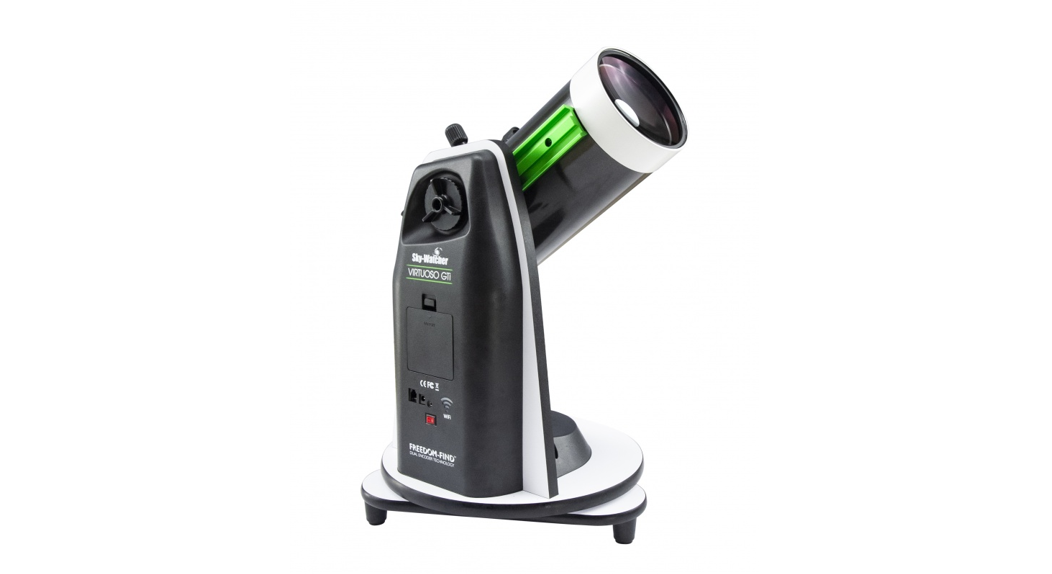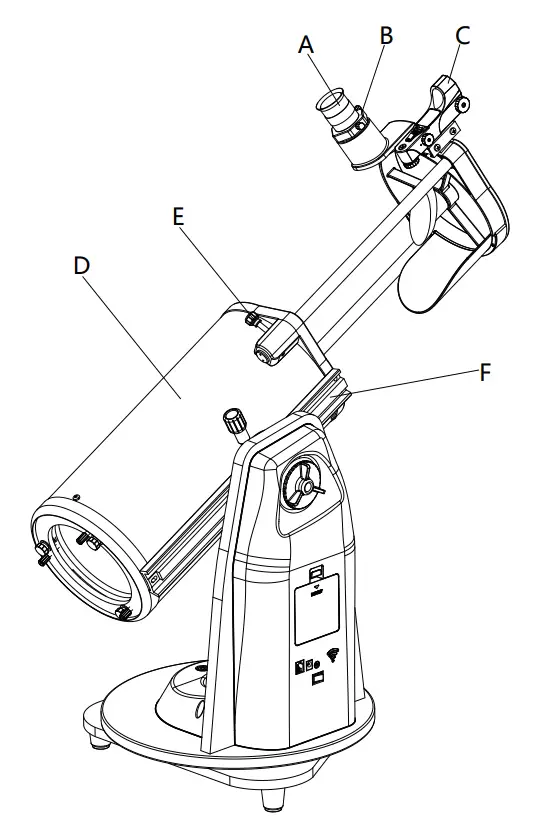INSTRUCTION MANUALVIRTUOSO GTi
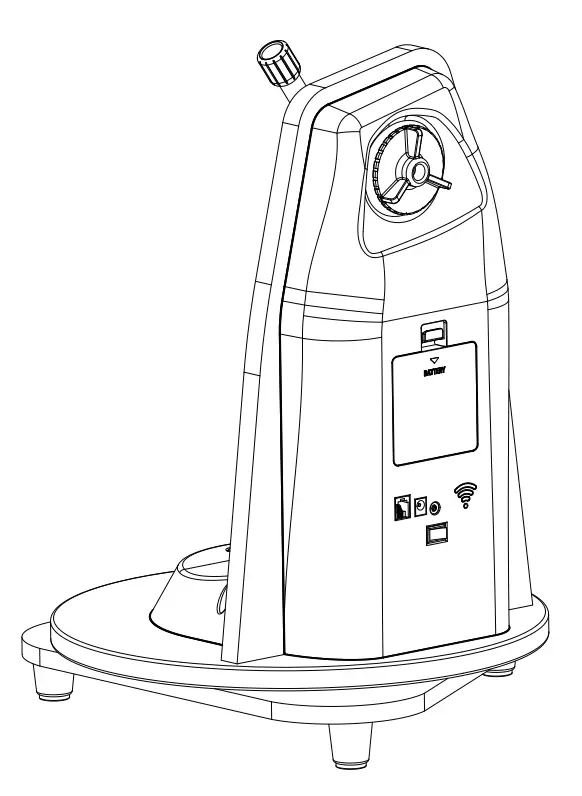
Parts Diagram
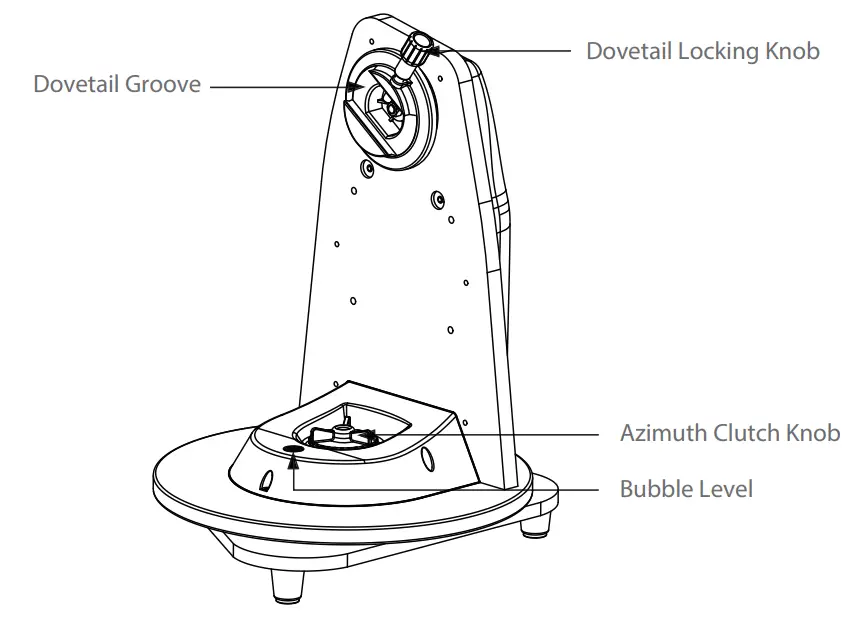 |
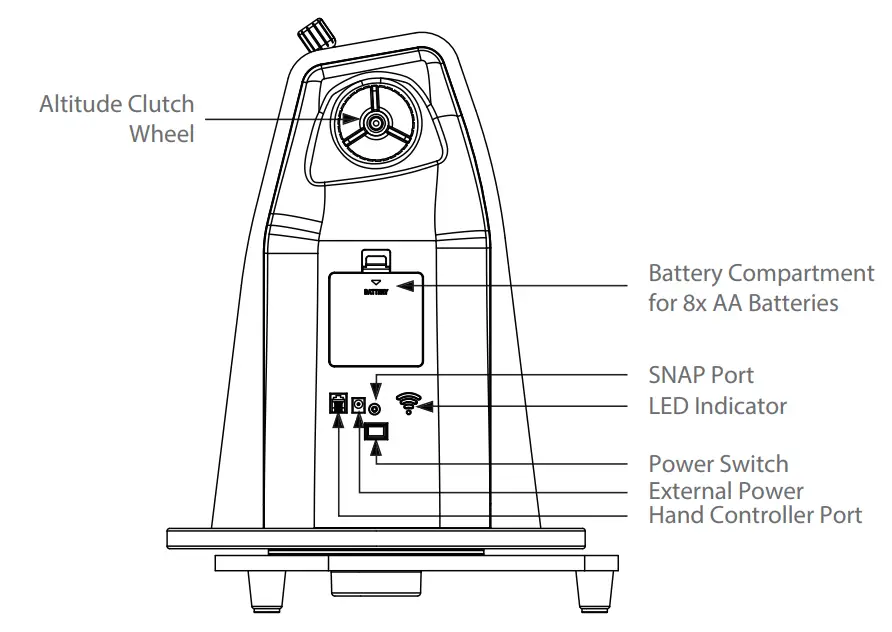 |
PART I: SETTING UP THE VIRTUOSO GTi MOUNT
1.1 Installing the Telescope
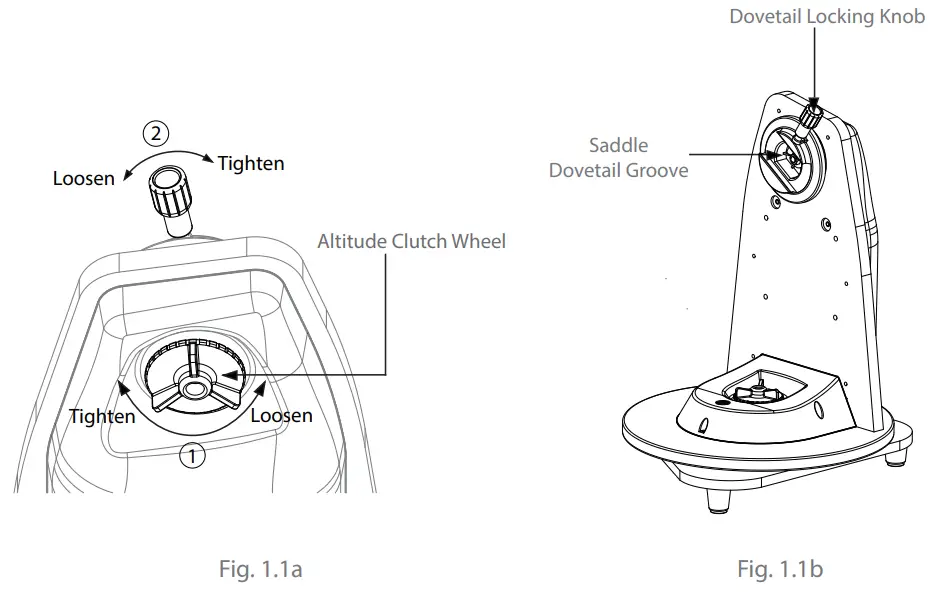
- Loosen the altitude clutch wheel and rotate the saddle until the dovetail groove is horizontal, then tighten the altitude clutch wheel again(Fig1.1a).
- Loosen the dovetail locking knob until nothing is obstructing the dovetail groove in the saddle (Fig1.1b).
- Hold the telescope horizontally and slide the dovetail bar of the telescope into the dovetail groove of the saddle (Fig 1.1b).
- Tighten the dovetail locking knob until the bar is securely locked in the groove. DO NOT LET GO OF THE TELESCOPE UNTIL YOU ARE SURE IT IS FIRMLY ATTACHED TO THE SADDLE
- While holding the telescope tube, fully loosen the altitude clutch to check the balance.
- Repeat the above steps to adjust the position of the dovetail bar back and forth to reach a good balance in the altitude axis.
PART II: ELECTRONIC CONTROL INTERFACE
2.1 Control PanelThe control panel of the VIRTUOSO GTi mount is shown below:

2.2 Panel Interface Components: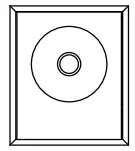 POWER: This is an input for external power to avoid running on the 8 AA batteries in the VIRTUOSO GTi mount battery compartment.
POWER: This is an input for external power to avoid running on the 8 AA batteries in the VIRTUOSO GTi mount battery compartment.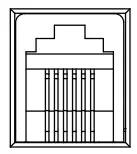 HAND CONTROL: This RJ-12 6-pins outlet is for connecting the SynScan hand controller.
HAND CONTROL: This RJ-12 6-pins outlet is for connecting the SynScan hand controller. SNAP: This is a stereo jack outlet to connect with a camera’s shutter control port.The SynScan hand control can control the camera to take pictures automatically via this interface.
SNAP: This is a stereo jack outlet to connect with a camera’s shutter control port.The SynScan hand control can control the camera to take pictures automatically via this interface. ON/OFF Switch: Turns the power to the mount and hand controller on and off.
ON/OFF Switch: Turns the power to the mount and hand controller on and off. Power LED: The power LED serves as a power-on indicator and provides other statuses.
Power LED: The power LED serves as a power-on indicator and provides other statuses.
- Steady on: Internal Wi-Fi is off.
- Intermittent one flash: Internal Wi-Fi is on.
- Intermittent two flashes: App has connected to internal Wi-Fi.
- Intermittent three flashes: Internal control board has entered firmware update mode.
2.3 Pinout of the Interfaces:
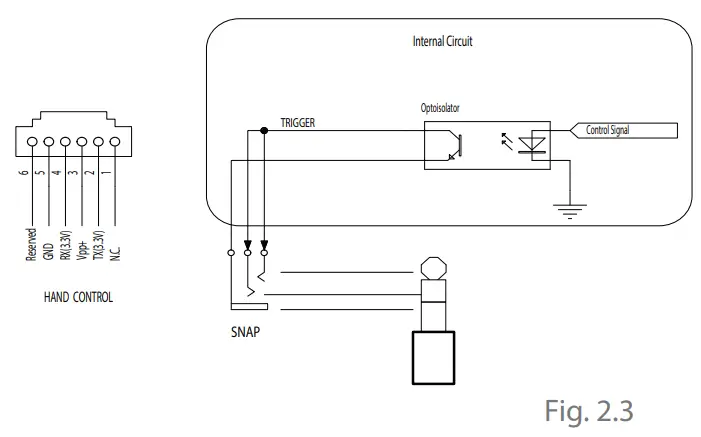
Note:The SNAP port provides two trigger signals to the stereo plug. For a camera that only needs a shutter-release signal, either trigger signal will work. For a camera that requires an extra “Focus” signal, both signals should be connected properly.2.4 DSLR Control CableAvailable for Canon, Nikon, Olympus, and Sony cameras. See the table below to select the appropriate cable for your camera model; it can be ordered from the local Skywatcher dealer.
| Part Number | Camera Interface Style | Controller Interface |
Compatible Camera Models |
| AP-R1C | Canon remote (E3 type) | Canon RS-60E3 | Canon EOS 100D, 300D/350D, 400D/450D, 500D/550D, 600D/650D, 700D, 60D/60Da, 70D |
| AP-R3C | Canon remote (N3 type) | Canon RS-80N3, TC- 80N3 | Canon EOS 5D/6D/7D,
10D/20D/30D/40D/50D, 1V, 10, 1Ds Mark Ill, 5D Mark Ill |
| AP-R1N | Nikon 10-pin remote terminal | Nikon MC-22, MC-30, MC-36 | .
Nikon D1/D2/03/D4 D200/D300/D700/D800 |
| AP-R2N | Nikon remote cord connector | Nikon MC-DC1 | Nikon D70S, D80 |
| AP-R3N | Nikon accessory terminal | Nikon MC-DC2 | Nikon D90, D600, D3000/D3100/D3200/ D3300,
D5000/D5100/D5200/05300, D7000/D7100 |
| AP-R1S | Sony remote terminal | Sony RM-S1AM, RM- L1AM | Sony a100, a200, a300, a350, a450, a550, a560
a700, a850, a900 |
| AP-R3L | Olympus multi-connector | RM-UC1 | Olympus E-P1/E-P2, E-PL2/E-PL3, E510/ E520/E550/E620, E400/E410/E420, SP-570UZ/SP-590UZ |
2.5 External Power Supply Requirements
- Input Voltage: DC 7.5V (minimum) to DC 14V (maximum). Voltage not in this range might cause permanent damage to the motor controller or the hand controller.
- Input Plug: Barrel type with 2.0mm I.D and 5.5mm O.D. Must be central positive.
- Input Current: At least 750mA.
- Do not use an unregulated AC-to-DC adapter. When choosing an AC adapter, a switching power supply with 12V output voltage and a minimum 750mA output current is recommended.
- If the power voltage is too high, the motor controller will stop the motors automatically.
PART III : USING THE VIRTUOSO GTi MOUNT
3.1 Manually Rotating the MountRefer to the following diagrams:
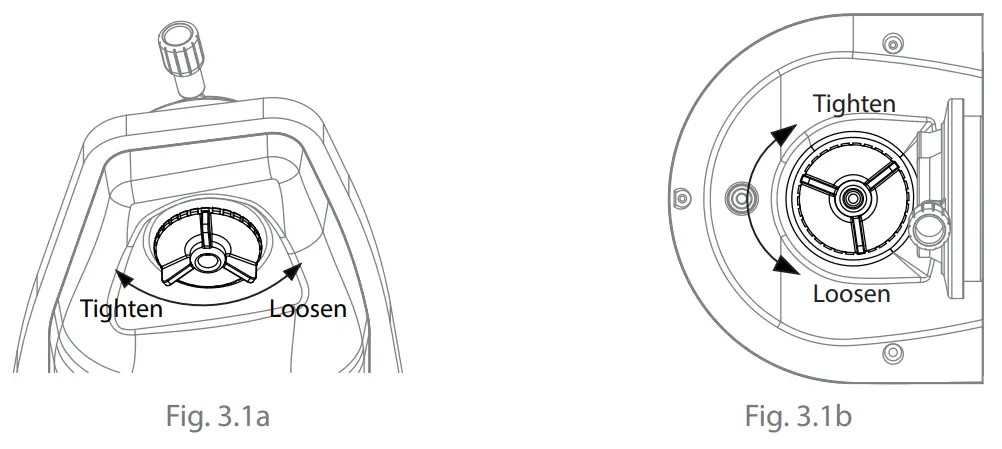
- Loosen the Alt clutch wheel to manually rotate the telescope vertically.
- Loosen the Azimuth adjustment knob to manually rotate the telescope horizontally.
Tips:
- Fully tighten the clutches for all motor-driven applications. This will give the best pointing accuracy.
- Half engage the clutches to manually point the telescope while preventing it from moving freely without external force.
- Fully loosen the clutches to move the telescope quickly.
3.2 Control with a SynScan Hand ControlPlugin the SynScan hand control into the hand control port in order to control the telescope and mount for astronomical observation. Please refer to the SynScan hand control manual for operating instructions.3.3 Control with a Mobile DeviceUsers can download the free “SynScan” App from the App Store( for iOS devices) or Google Play (for Android Devices) for astronomical observation. Skywatcher will also provide apps for photography. Please check the stores for availability.3.4 Wi-Fi Connection
- The user must connect to the mount’s Wi-Fi within 15 minutes after turning on the power. The Wi-Fi will be turned off automatically if no connection is established within 15 minutes, .
- By default, the SSID of the built-in Wi-Fi is “SynScan_xxxx” and there is no password. Users can download Skywatcher’s “SynScan” app from App Store or Google Play to configure the mount’s built-in Wi-Fi.
- Reset Wi-Fi configuration to factory default by turning on the power without the SynScan hand control connected and no App operations via the Wi-Fi connection for 1 hour.
3.5 Freedom FindTM FunctionThe VIRTUOSO GTi mount is equipped with auxiliary encoders on both the azimuth axis and altitude axis. Therefore, the mount can keep track of its current position even when a user unlocks the clutches and rotates the mount in azimuth axis and altitude axis manually.With this feature, a user can manually operate the mount anytime without worrying about losing the mount’s alignment status. When the user wants to operate the mount with the SynScan hand control again, no alignment is required and all that is needed to be done is to re-lock the clutches.This feature can be disabled with the SynScan hand controller or the SynScan App. If a user does not need to rotate the mount manually after alignment, it is recommended to disable this feature to obtain the best pointing accuracy.3.6 Firmware UpdateWhen a new firmware for the control board inside the mount is available, Skywatcher will release it on www.skywatcher.com. Users can visit this website to download the firmware and the necessary application to update the firmware.
PART IV: Assembling Your Telescope
|
REFLECTOR
|
REFLECTOR
|
| A. Focus knobB. EyepieceC. Red Dot FinderD. Red Dot Finder BracketE. Telescope Main TubeF. Dovetail | A. Focus knobB. EyepieceC. Red Dot FinderD. Red Dot Finder BracketE. Telescope Main TubeF. Dovetail |
MAKSUTOV
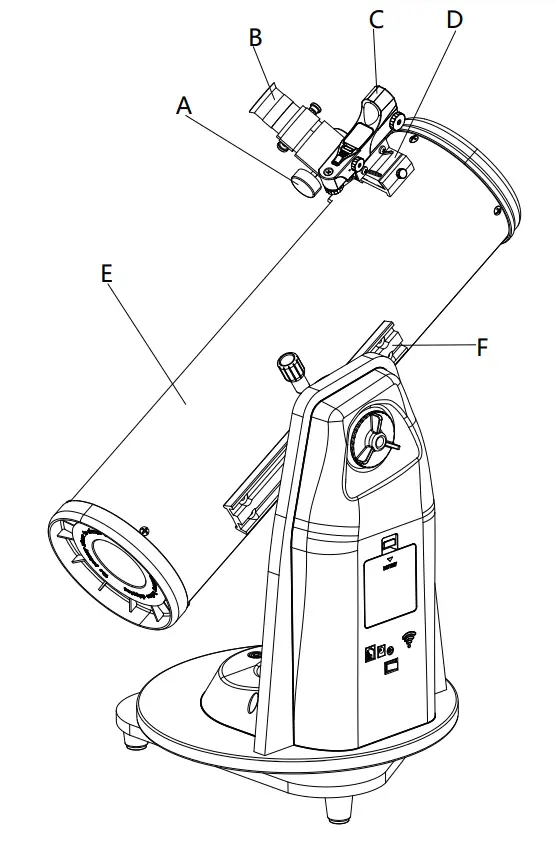


| A. Red Dot FinderB. Red Dot Finder BracketC. Telescope Main TubeD. Eyepiece | E. DovetailF. DiagonalG. Focus knob |
Before you beginThis instruction manual is applicable to 3 models. Take a moment to find the model of your telescope. Follow the instructions for your specific model in the manual. Read the entire instructions carefully before beginning. Your telescope should be assembled during daylight hours. Choose a large, open area to work to allow room for all parts to be unpacked.4.1 Finderscope/Red Dot Finder Assembly
- Attaching the red dot finder(Fig.4.1.1a)• Slide the red dot finder bracket into the rectangle and tighten the screw to hold the red dot finder in place.

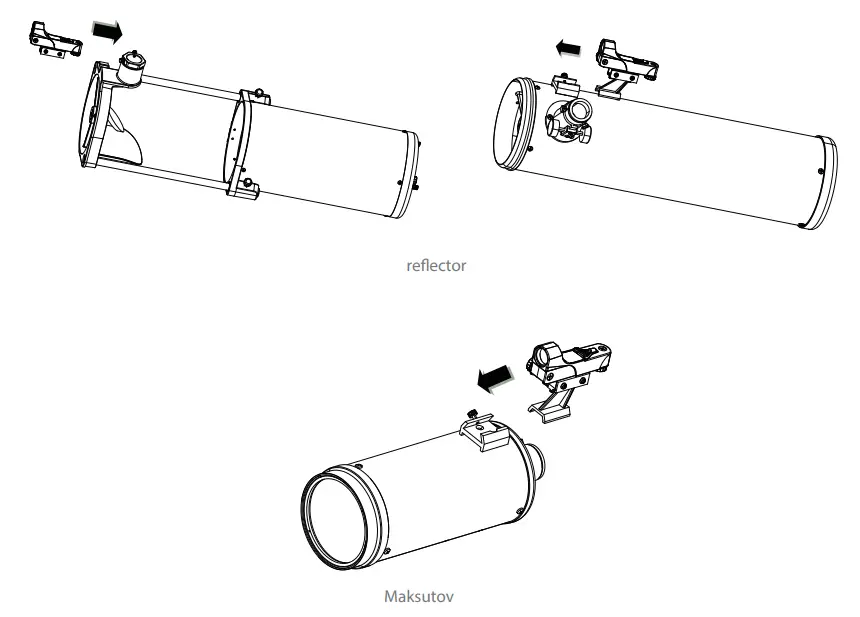
4.2 Eyepiece Assembly
- Inserting eyepiece for Maksutov(Fig.4.2.1a)• Loosen the thumbscrew on the end of the focus tube.• Insert the diagonal into the focus tube and re-tighten the thumbscrew to hold the diagonal in place.• Lose the thumbscrews on the diagonal.• Insert the desired eyepiece into diagonal and secure by re-tightening thumbscrews.


- Inserting eyepiece for reflector(Fig:4.2.2a)• Unscrew the thumbscrews on the end of the focus tube to remove the black plastic endcap.• Insert the desired eyepiece then re-tighten thumbscrews to hold the eyepiece in place.
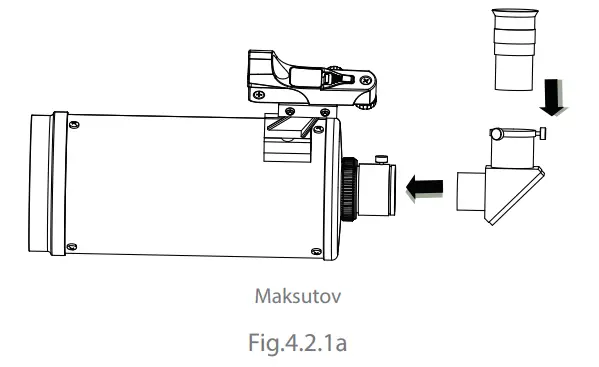
PART V: Operating Your Telescope
5.1 Using the Red Dot FinderThe Red Dot Finder is a zero magnification pointing tool that uses a coated glass window to superimpose the image of a small red dot onto the night sky. The Red Dot Finder is equipped with variable brightness control, azimuth adjustment control, and altitude adjustment control (Fig.5.1).
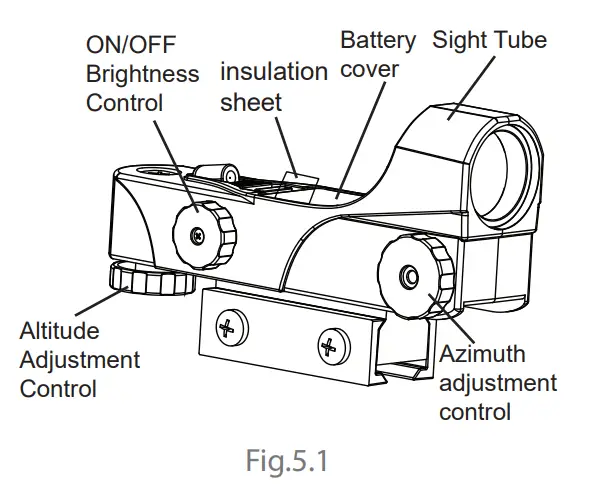

The Red Dot Finder is powered by a 3-volt lithium battery located on top. To use the Finder, simply look through the sight tube and move your telescope until the red dot merges with the object. Make sure to keep both eyes open when sighting.Aligning the Red Dot Finder Like all finderscopes, the Red Dot Finder must be properly aligned with the main telescope before use. This is a simple process using the azimuth and altitude control knobs.
- Please open the battery cover and remove the insulation sheet.
- Turn on the Red Dot Finder by rotating the variable brightness control clockwise until you hear a “click”. Continue rotating the control knob to increase the brightness level.
- Insert the 25mm eyepiece into the telescope’s focuser. Locate a bright object and position the telescope so that the object is in the center of the field of view of the eyepiece.
- With both eyes open, look through the sight tube at the object. If the red dot overlaps the object, your Red Dot Finder is perfectly aligned. If not, turn its azimuth and altitude adjustment controls until the red dot is merged with the object.
5.2 Focusing the Telescope
- Slowly turn the focus knobs under the focuser, one way or the other, until the image in the eyepiece is sharp (Fig.5.2a). The image usually has to be finely refocused over time, due to small variations caused by temperature changes, flexures, etc. This often happens with short focal ratio telescopes, particularly when they haven’t yet reached outside temperature. Refocusing is almost always necessary when you change an eyepiece.
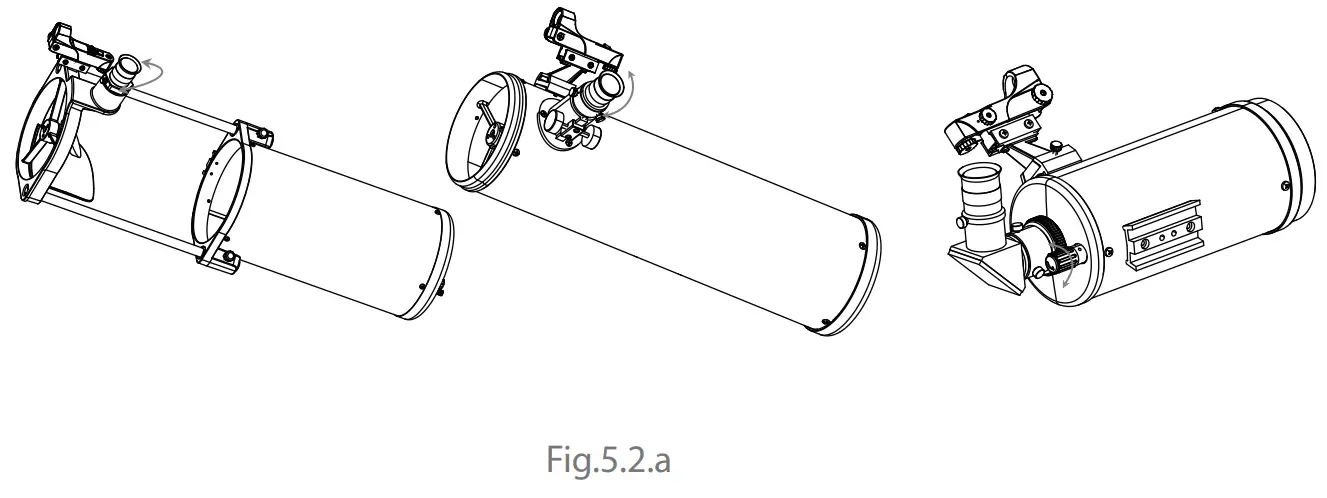

5.3 Choosing the Appropriate Eyepiece
- The magnification produced by a telescope is determined by the focal length of the eyepiece that is used with it. To determine a magnification for your telescope, divide its focal length by the focal length of the eyepieces you are going to use. For example, a 10mm focal length eyepiece will give 80X magnification with an 800mm focal length telescope.
- When you are looking at astronomical objects, you are looking through a column of air that reaches the edge of space and that column seldom stays still. Similarly, when viewing over land you are often looking through heat waves radiating from the ground, houses, buildings, etc. Your telescope may be able to give very high magnification but what you end up magnifying is all the turbulence between the telescope and the subject. A good rule of thumb is that the usable magnification of a telescope is about 2X per mm of aperture under good conditions.
- Too much magnification and too small a field of view can make it very hard to find things.It is usually best to start at a lower magnification with its wider field of view and then increase the magnification when you have found what you are looking for. First, find the moon then look at the shadows in the craters!
PART VI: Observing the sky
6.1 Sky Conditions
- Sky conditions are usually defined by two atmospheric characteristics seeing or the steadiness of the air, and transparency, light scattering due to the amount of water vapor and particulate material in the air. When you observe the Moon and the planets, and they appear as though water is running over them, you probably have bad “seeing” because you are observing through turbulent air. In conditions of good “seeing”, the stars appear steady, without twinkling, when you look at them with unassisted eyes (without a telescope). Ideal “transparency” is when the sky is inky black and the air is unpolluted.
6.2 Selecting an Observing Site
- Travel to the best site that is reasonably accessible. It should be away from city lights, and upwind from any source of air pollution. Always choose as high an elevation aspossible; this will get you above some of the lights and pollution and will ensure that you aren’t in any ground fog. Sometimes low fog banks help to block light pollution if you get above them. Try to have a dark, unobstructed view of the horizon, especially the southern horizon if you are in the Northern Hemisphere and vice versa.However, remember that the darkest sky is usually at the “Zenith”, directly above your head. It is the shortest path through the atmosphere. Do not try to observe an object when the light path passes near any protrusion on the ground. Even extremely light winds can cause major air turbulence as they flow over the top of a building or wall. Observing through a window is not recommended because the window glass will distort images considerably. And an open window can be even worse, because warmer indoor air will escape out the window, causing turbulence which also affects images. Astronomy is an outdoor activity. The best conditions will have still air, and obviously, a clear view of the sky. It is not necessary that the sky be cloud-free. Often broken cloud conditions provide excellent seeing.
6.3 Choosing the Best Time to Observe
- Do not view immediately after sunset. After the sun goes down, the Earth is still cooling, causing air turbulence. As the night goes on, not only will see improvement, but air pollution and ground lights will often diminish. Some of the best observing time is often in the early morning hours. Objects are best observed as they cross the meridian, which is an imaginary line that runs through the Zenith, due North-South.This is the point at which objects reach their highest points in the sky. Observing at this time reduces bad atmospheric effects. When observing near the horizon, you look through lots of atmospheres, complete with turbulence, dust particles, and increased light pollution.
6.4 Cooling the Telescope
- Telescopes require at least 10 to 30 minutes to cool down to outside air temperature. This may take longer if there is a big difference between the temperature of the telescope and the outside air. This minimizes heatwave distortion inside the telescope tube (tube currents).Allow a longer cooling time for larger optics.
6.5 Adapting Your Eyes
- Do not expose your eyes to anything except red light for 30 minutes prior to observing.This allows your pupils to expand to their maximum diameter and build up the levels of optical pigments, which are rapidly lost if exposed to bright light. It is important to observe with both eyes open. This avoids fatigue at the eyepiece. if you find this to distracting cover the non-used eye with your hand or an eye patch. Use averted vision on faint objects: The center of your eye is the least sensitive to low light levels. When viewing a faint object, don’t look directly at it. Instead, look slightly to the side, and the object will appear brighter.
6.6 Download SynScan or SynScan Pro APP
6.7 Download SynScan App User’s Manual
6.8 Wireless Telescope Control
- The VIRTUOSO GTi mount will be equipped with a telescope optical tube for astronomy observation purposes. Please refer to the telescope optical tube manual for use of the telescope and its accessories.Aiming the telescope automatically with the VIRTUOSO GTi mount, connected to your smart device equipped with WiFi (smartphone, tablet, laptop):-Make sure the freely available software (SynScan or SynScan Pro) app is installed on your smart device. You can find them in your App Store, Google Play, or on our webpage– Switch on the VIRTUOSO GTi mount.– Connect your smart device with the WiFi signal with identification “SynScan …..”– Refer to SynScan App User’s Manual.
- The Wi-Fi will be turned off automatically to conserve energy if no connection is established within 15 minutes after being turned on.By default, the SSID of the built-in Wi-Fi is “SynScan_xxxx” with no password.Reset Wi-Fi configuration to factory default by turning on the power without the SynScan hand control connected and no app operations via the Wi-Fi connection for 1 hour.Entry-level users are recommended to start with the SynScan app, the SynScan Pro app is for experienced users.
6.9 Wireless Terrestrial Photography Control
- The VIRTUOSO GTi mount can be equipped with a camera for terrestrial panorama photography, timelapse photography, etc.The connection procedure is identical. The app to be installed is different: SynScan Photo.
PART VII: Proper Care for Your Telescope
7.1 CollimationCollimation is the process of aligning the mirrors of your telescope so that they work in concert with each other to deliver properly focused light to your eyepiece. By observing out-of-focus star images, you can test whether your telescope’s optics are aligned. Place a star in the center of the field of view and move the focuser so that the image is slightly out of focus. If the seeing conditions are good, you will see a central circle of light (the Airy disc) surrounded by a number of diffraction rings. If the rings are symmetrical about the Airy disc, the telescope’s optics are correctly aligned (Fig. 7.1a).
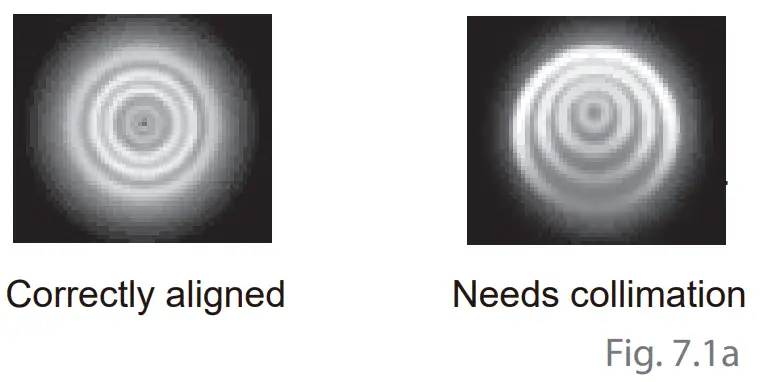

If not, the two mirrors in the telescope are not properly aligned and collimation is needed. A collimation aid is supplied with the accessories. It is a plastic cap with a small hole in its center, which fits the focuser of the telescope when the eyepiece is removed. Let’s call it the collimation cap.Collimation is a painless process and works like this:Pull off the lens cap which covers the front of the telescope and look down the optical tube. At the bottom, you will see the primary mirror held in place by three clips 120° apart and at the top, the small oval secondary mirror is held in support and tilted 45 toward the focuser outside the tube wall (Fig. 7.1b).
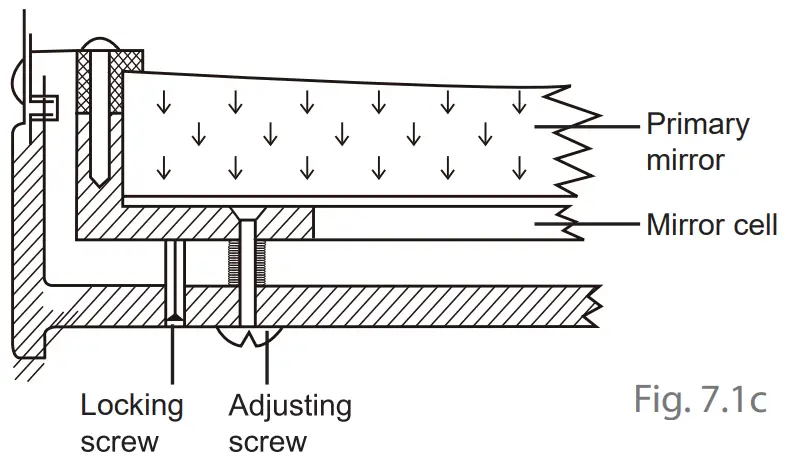

The secondary mirror is aligned by adjusting the three smaller screws surrounding the central bolt. The primary mirror is adjusted by the three adjusting screws at the back of your scope. The three locking screws beside them serve to hold the mirror in place after collimation. (Fig. 7.1c)
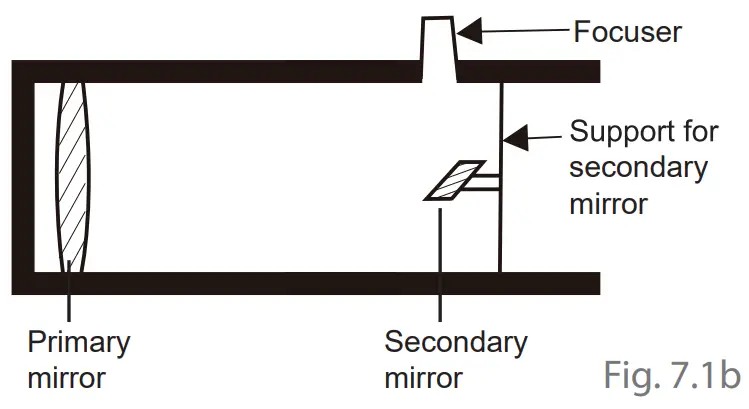

Aligning the Secondary MirrorPoint the telescope at a lit wall and insert the collimation cap into the focuser in place of a regular eyepiece. Look into the focuser through your collimation cap. You mayhave to twist the focus knob a few turns until the reflected image of the focuser is out of your view. ignore the reflected image of the collimating cap or your eye for now, instead look for the three clips holding the primary mirror in place. If you can’t see them, it means that you will have to adjust the three bolts on the top of the secondary mirror holder, with possibly an Allen wrench or Phillip’s screwdriver. You will have to alternately loosen one and then compensate for the slack by tightening the other two. Stop when you see all three mirror clips (Fig. 7.1d and 7.1e), Make sure that all three small alignment screws are tightened to secure the secondary mirror in place.
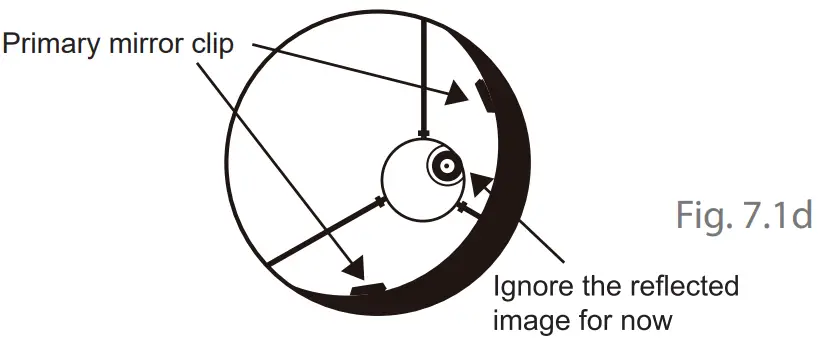  |
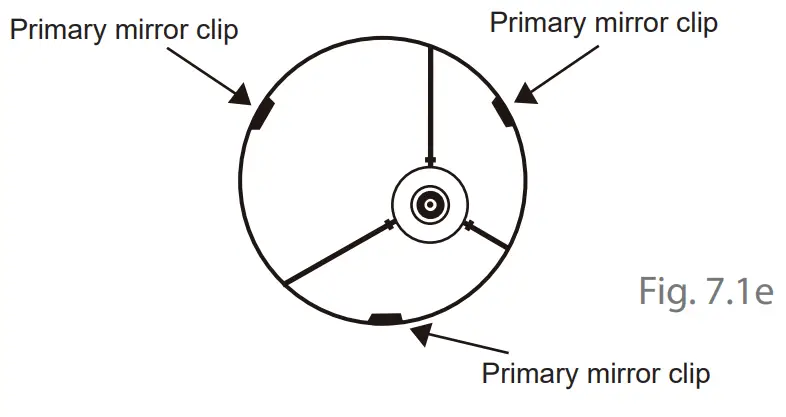  |
Aligning the Primary MirrorThere are 3 large bolts and 3 small screws at the back of your telescope. The large bolts are the adjusting screws and the small screws are the locking screws (Fig.7.1f).
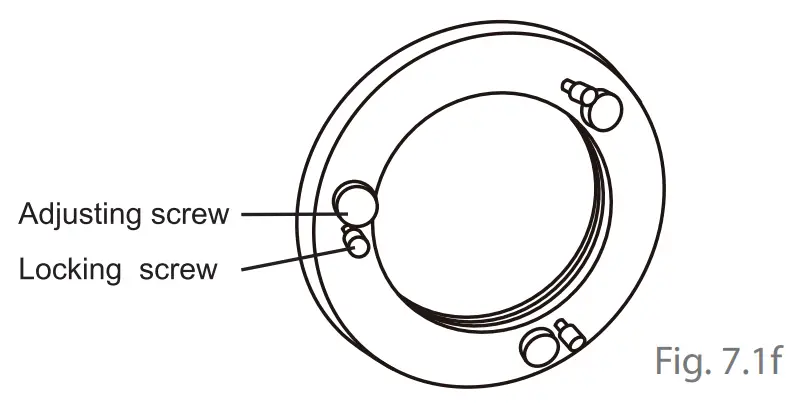

Loosen the large bolts by a few turns. Now run your hand around the front of your telescope keeping your eye to the focuser, you will see the reflected image of your hand. The idea here is to see which way the primary mirror defects, you do this by stopping at the point where the reflected image of the secondary mirror is closest to the primarymirrors’ edge (Fig. 7.1g).
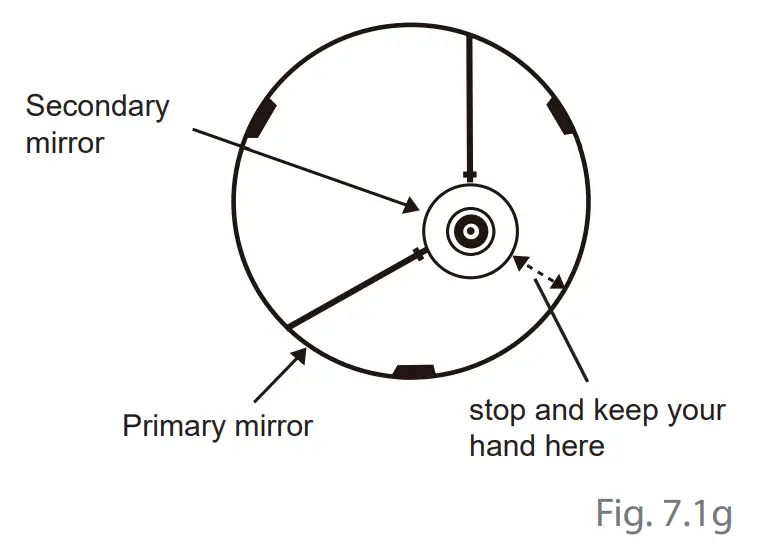

When you get to that point, stop and keep your hand there while looking at the back end of your telescope, is there an adjusting screw there? If there is you will want to loosen it (turn the screw to the left) to bring the mirror away from that point. If there isn’t an adjusting screw there, then go across to the other side and tighten the adjusting screw on the other side. This will gradually bring the mirror into line until it looks like Fig.7.1h. (It helps to have a friend to help with primary mirror collimation, Have your partner adjust the adjusting screws according to your direction while you look in the focuser.)
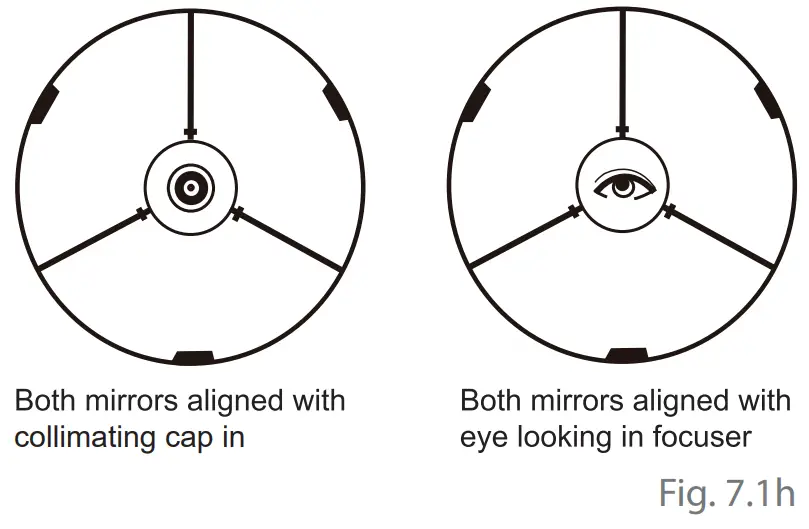

After dark go out and point your telescope at a bright star, and put the high power eyepiece (10mm) in the focuser. Keep that bright star well centered in the middle of the eyepiece image. Check now the collimation by looking at its airy disk as described (fig. 7.1a).If it is not symmetric, you can improve the symmetry by acting on the adjustment screws of the primary mirror in a similar way as what you did in the daytime to achieve the symmetry of fig. 7.1h.Once the symmetry is there, then collimation is done and the locking screws can be tightened to make the adjustment permanent.7.2 Cleaning Your TelescopeReplace the dust cap over the end of the telescope whenever not in use. This prevents dust from settling on the mirror or lens surface. Do not clean mirrors or lenses unless you are familiar with optical surfaces. Clean eyepieces with special lens paper only. Eyepieces should be then dled with care, avoiding touching optical surfaces.
VIRTUOSO GTi Mount
![]()
![]()
Copyright © Sky-Watcher202102V1
References
[xyz-ips snippet=”download-snippet”]

